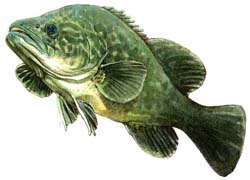Murray Cod

Common Name: Murray Cod
Scientific Name: Aphyonus gelatinosus
Description
The Murray Cod is a moderately elongate, deep-bodied fish. It has a concave snout profile, a large mouth and small eyes.
This species is olive to cream or yellowish with a reticulated pattern of green markings on the back and sides. It is white to cream below. The median fins are dusky with white margins. The pelvic fins are white.
The Murray Cod has also been referred to as Cod, Goodoo, Ponde and Pondi. The last three names are examples of the many Aboriginal names for this species.
Size
The Murray Cod is Australia's largest freshwater fish. It is a prized angling species that can grows to a length of 1.8 m and weight of 113.5 kg. It is more commonly seen up to 70 cm in length and under 10 kg.
Diet
On hatching the fry feed on zooplankton (most easily obtained in billabongs and backwaters) with the diet gradually changing to include yabbies, shrimp, molluscs and fishes.
Characteristics
The adults (usually about 60 cm but can be up to 180 cm) breed when the water temperature reaches about 20ºC with the female producing up to 60,000 eggs 2-3 mm in diameter.
Location or Region Found
This fish is endemic to Australia, occurring in freshwaters of the Murray-Darling River drainage in Queensland, New South Wales, Victoria and South Australia. There are also erroneous reports from the Dawson-Fitzroy drainage.
Murray Cod populations have declined dramatically since white settlement of Australia. A commercial fishery between the 1880s and 1930s caused an initial decline. More recently, overfishing, river degradation and human modification of the environment have caused major population declines. Murray Cod are now relatively uncommon in most areas.
 Deep Sea Crabs
Deep Sea Crabs